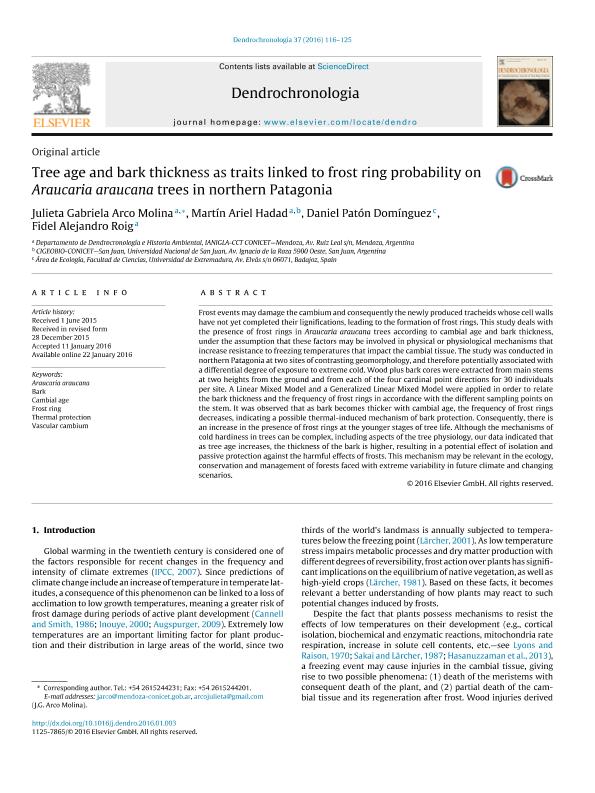Mostrar el registro sencillo del ítem
dc.contributor.author
Arco Molina, Julieta Gabriela

dc.contributor.author
Hadad, Martín Ariel

dc.contributor.author
Patón Domínguez, Daniel
dc.contributor.author
Roig Junent, Fidel Alejandro

dc.date.available
2018-09-24T14:43:06Z
dc.date.issued
2016-03
dc.identifier.citation
Arco Molina, Julieta Gabriela; Hadad, Martín Ariel; Patón Domínguez, Daniel; Roig Junent, Fidel Alejandro; Tree age and bark thickness as traits linked to frost ring probability on Araucaria araucana trees in northern Patagonia; Elsevier Gmbh, Urban & Fischer Verlag; Dendrochronologia; 37; 3-2016; 116-125
dc.identifier.issn
1125-7865
dc.identifier.uri
http://hdl.handle.net/11336/60719
dc.description.abstract
Frost events may damage the cambium and consequently the newly produced tracheids whose cell walls have not yet completed their lignifications, leading to the formation of frost rings. This study deals with the presence of frost rings in Araucaria araucana trees according to cambial age and bark thickness, under the assumption that these factors may be involved in physical or physiological mechanisms that increase resistance to freezing temperatures that impact the cambial tissue. The study was conducted in northern Patagonia at two sites of contrasting geomorphology, and therefore potentially associated with a differential degree of exposure to extreme cold. Wood plus bark cores were extracted from main stems at two heights from the ground and from each of the four cardinal point directions for 30 individuals per site. A Linear Mixed Model and a Generalized Linear Mixed Model were applied in order to relate the bark thickness and the frequency of frost rings in accordance with the different sampling points on the stem. It was observed that as bark becomes thicker with cambial age, the frequency of frost rings decreases, indicating a possible thermal-induced mechanism of bark protection. Consequently, there is an increase in the presence of frost rings at the younger stages of tree life. Although the mechanisms of cold hardiness in trees can be complex, including aspects of the tree physiology, our data indicated that as tree age increases, the thickness of the bark is higher, resulting in a potential effect of isolation and passive protection against the harmful effects of frosts. This mechanism may be relevant in the ecology, conservation and management of forests faced with extreme variability in future climate and changing scenarios.
dc.format
application/pdf
dc.language.iso
eng
dc.publisher
Elsevier Gmbh, Urban & Fischer Verlag

dc.rights
info:eu-repo/semantics/openAccess
dc.rights.uri
https://creativecommons.org/licenses/by-nc-sa/2.5/ar/
dc.subject
Araucaria Araucana
dc.subject
Bark
dc.subject
Cambial Age
dc.subject
Frost Ring
dc.subject
Thermal Protection
dc.subject
Vascular Cambium
dc.subject.classification
Meteorología y Ciencias Atmosféricas

dc.subject.classification
Ciencias de la Tierra y relacionadas con el Medio Ambiente

dc.subject.classification
CIENCIAS NATURALES Y EXACTAS

dc.title
Tree age and bark thickness as traits linked to frost ring probability on Araucaria araucana trees in northern Patagonia
dc.type
info:eu-repo/semantics/article
dc.type
info:ar-repo/semantics/artículo
dc.type
info:eu-repo/semantics/publishedVersion
dc.date.updated
2018-09-12T14:01:19Z
dc.journal.volume
37
dc.journal.pagination
116-125
dc.journal.pais
Alemania

dc.journal.ciudad
Berlín
dc.description.fil
Fil: Arco Molina, Julieta Gabriela. Consejo Nacional de Investigaciones Científicas y Técnicas. Centro Científico Tecnológico Conicet - Mendoza. Instituto Argentino de Nivología, Glaciología y Ciencias Ambientales. Provincia de Mendoza. Instituto Argentino de Nivología, Glaciología y Ciencias Ambientales. Universidad Nacional de Cuyo. Instituto Argentino de Nivología, Glaciología y Ciencias Ambientales; Argentina
dc.description.fil
Fil: Hadad, Martín Ariel. Consejo Nacional de Investigaciones Científicas y Técnicas. Centro Científico Tecnológico Conicet - Mendoza. Instituto Argentino de Nivología, Glaciología y Ciencias Ambientales. Provincia de Mendoza. Instituto Argentino de Nivología, Glaciología y Ciencias Ambientales. Universidad Nacional de Cuyo. Instituto Argentino de Nivología, Glaciología y Ciencias Ambientales; Argentina. Consejo Nacional de Investigaciones Científicas y Técnicas. Centro Científico Tecnológico Conicet - San Juan. Centro de Investigaciones de la Geosfera y Biosfera. Universidad Nacional de San Juan. Facultad de Ciencias Exactas Físicas y Naturales. Centro de Investigaciones de la Geosfera y Biosfera; Argentina
dc.description.fil
Fil: Patón Domínguez, Daniel. Universidad de Extremadura; España
dc.description.fil
Fil: Roig Junent, Fidel Alejandro. Consejo Nacional de Investigaciones Científicas y Técnicas. Centro Científico Tecnológico Conicet - Mendoza. Instituto Argentino de Nivología, Glaciología y Ciencias Ambientales. Provincia de Mendoza. Instituto Argentino de Nivología, Glaciología y Ciencias Ambientales. Universidad Nacional de Cuyo. Instituto Argentino de Nivología, Glaciología y Ciencias Ambientales; Argentina
dc.journal.title
Dendrochronologia

dc.relation.alternativeid
info:eu-repo/semantics/altIdentifier/doi/https://dx.doi.org/10.1016/j.dendro.2016.01.003
dc.relation.alternativeid
info:eu-repo/semantics/altIdentifier/url/https://www.sciencedirect.com/science/article/pii/S1125786516000072
Archivos asociados
